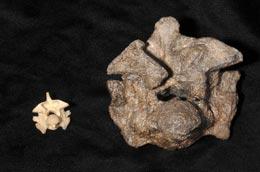| Topic: Ancient Fossil Find: Snake Could Eat A Cow | |
|---|---|
|
Now this snake would have scared me!
By MALCOLM RITTER, AP Science Writer Malcolm Ritter, Ap Science Writer – 1 hr 46 mins ago NEW YORK – Never mind the 40-foot snake that menaced Jennifer Lopez in the 1997 movie "Anaconda." Not even Hollywood could match a new discovery from the ancient world. Fossils from northeastern Colombia reveal the biggest snake ever discovered: a behemoth that stretched 42 to 45 feet long, reaching more than 2,500 pounds. "This thing weighs more than a bison and is longer than a city bus," enthused snake expert Jack Conrad of the American Museum of Natural History in New York, who was familiar with the find. "It could easily eat something the size of a cow. A human would just be toast immediately." "If it tried to enter my office to eat me, it would have a hard time squeezing through the door," reckoned paleontologist Jason Head of the University of Toronto Missisauga. Actually, the beast probably munched on ancient relatives of crocodiles in its rainforest home some 58 million to 60 million years ago, he said. Head is senior author of a report on the find in Thursday's issue of the journal Nature. The discoverers of the snake named it Titanoboa cerrejonensis ("ty-TAN-o-BO-ah sare-ah-HONE-en-siss"). That means "titanic boa from Cerrejon," the region where it was found. While related to modern boa constrictors, it behaved more like an anaconda and spent almost all its time in the water, Head said. It could slither on land as well as swim. Conrad, who wasn't involved in the discovery, called the find "just unbelievable.... It mocks your preconceptions about how big a snake can get." Titanoboa breaks the record for snake length by about 11 feet, surpassing a creature that lived about 40 million years ago in Egypt, Head said. Among living snake species, the record holder is an individual python measured at about 30 feet long, which is some 12 to 15 feet shorter than typical Titanoboas, said study co-author Jonathan Bloch. The beast was revealed in early 2007 at the University of Florida's Florida Museum of Natural History in Gainesville. Bones collected at a huge open-pit coal mine in Colombia were being unpacked, said Bloch, the museum's curator of vertebrate paleontology. Graduate students unwrapping the fossils "realized they were looking at the bones of a snake. Not only a snake, but a really big snake." So they quickly consulted the skeleton of a 17-foot anaconda for comparison. A backbone from that creature is about the size of a silver dollar, Bloch said, while a backbone from Titanoboa is "the size of a large Florida grapefruit." So far the scientists have found about 180 fossils of backbone and ribs that came from about two dozen individual snakes, and now they hope to go back to Colombia to find parts of the skull, Bloch said. Titanoboa's size gives clues about its environment. A snake's size is related to how warm its environment is. The fossils suggest equatorial temperatures in its day were significantly warmer than they are now, during a time when the world as a whole was warmer. So equatorial temperatures apparently rose along with the global levels, in contrast to the competing hypothesis that they would not go up much, Head noted. "It's a leap" to apply the conditions of the past to modern climate change, Head said. But given that, the finding still has "some potentially scary implications for what we're doing to the climate today," he said. The finding suggest the equatorial regions will warm up along with the planet, he said. "We won't have giant snakes, however, because we are removing most of their habitats by development and deforestation" in equatorial regions, he said. |
|
|
|
|
|
Now this snake would have scared me! By MALCOLM RITTER, AP Science Writer Malcolm Ritter, Ap Science Writer – 1 hr 46 mins ago NEW YORK – Never mind the 40-foot snake that menaced Jennifer Lopez in the 1997 movie "Anaconda." Not even Hollywood could match a new discovery from the ancient world. Fossils from northeastern Colombia reveal the biggest snake ever discovered: a behemoth that stretched 42 to 45 feet long, reaching more than 2,500 pounds. "This thing weighs more than a bison and is longer than a city bus," enthused snake expert Jack Conrad of the American Museum of Natural History in New York, who was familiar with the find. "It could easily eat something the size of a cow. A human would just be toast immediately." "If it tried to enter my office to eat me, it would have a hard time squeezing through the door," reckoned paleontologist Jason Head of the University of Toronto Missisauga. Actually, the beast probably munched on ancient relatives of crocodiles in its rainforest home some 58 million to 60 million years ago, he said. Head is senior author of a report on the find in Thursday's issue of the journal Nature. The discoverers of the snake named it Titanoboa cerrejonensis ("ty-TAN-o-BO-ah sare-ah-HONE-en-siss"). That means "titanic boa from Cerrejon," the region where it was found. While related to modern boa constrictors, it behaved more like an anaconda and spent almost all its time in the water, Head said. It could slither on land as well as swim. Conrad, who wasn't involved in the discovery, called the find "just unbelievable.... It mocks your preconceptions about how big a snake can get." Titanoboa breaks the record for snake length by about 11 feet, surpassing a creature that lived about 40 million years ago in Egypt, Head said. Among living snake species, the record holder is an individual python measured at about 30 feet long, which is some 12 to 15 feet shorter than typical Titanoboas, said study co-author Jonathan Bloch. The beast was revealed in early 2007 at the University of Florida's Florida Museum of Natural History in Gainesville. Bones collected at a huge open-pit coal mine in Colombia were being unpacked, said Bloch, the museum's curator of vertebrate paleontology. Graduate students unwrapping the fossils "realized they were looking at the bones of a snake. Not only a snake, but a really big snake." So they quickly consulted the skeleton of a 17-foot anaconda for comparison. A backbone from that creature is about the size of a silver dollar, Bloch said, while a backbone from Titanoboa is "the size of a large Florida grapefruit." So far the scientists have found about 180 fossils of backbone and ribs that came from about two dozen individual snakes, and now they hope to go back to Colombia to find parts of the skull, Bloch said. Titanoboa's size gives clues about its environment. A snake's size is related to how warm its environment is. The fossils suggest equatorial temperatures in its day were significantly warmer than they are now, during a time when the world as a whole was warmer. So equatorial temperatures apparently rose along with the global levels, in contrast to the competing hypothesis that they would not go up much, Head noted. "It's a leap" to apply the conditions of the past to modern climate change, Head said. But given that, the finding still has "some potentially scary implications for what we're doing to the climate today," he said. The finding suggest the equatorial regions will warm up along with the planet, he said. "We won't have giant snakes, however, because we are removing most of their habitats by development and deforestation" in equatorial regions, he said. a few years back there was a live reticulated python found in indonesia that was 49 feet long ate 3 or 4 dogs a month... just a sec and i'll look it up! http://www.msnbc.msn.com/id/3845750/ 
|
|
|
|
|
|
Edited by
Winx
on
Wed 02/04/09 10:30 AM
|
|
|
S1owhand,
Whoa, wow!! 
Have been know to attack and consume humans. 
|
|
|
|
|
|
trying to find a large reticulated python.... i not even gonna go there
|
|
|
|
|
|
Just think about how many hatbands you could have made with one of those suckas !!
|
|
|
|
|
|
Just think about how many hatbands you could have made with one of those suckas !! It would make some nice boots too. |
|
|
|
|
|
i had a friend whose boa constrictor pet got to be too much. she grew to 5 or 6 feet and got so strong she could lift the lid of her cage when the entire encyclopedia was stacked on top...i remember when she was only 5 or 6 inches long...
my friend ended up giving/selling her to a chinese college professor who liked snake to eat... 
i heard he thought she was delicious. |
|
|
|
|
|
the way I figure it - the days of giganticism as in dino's and Titanoboa cerrejonensis ("ty-TAN-o-BO-ah sare-ah-HONE-en-siss" just had to end. The earth is simply not big enough to support a steady and thriving population of titanically propotioned beings. So we 'human' animals took over - now we can destroy the enironment before we could ever 'eat' our way through it....
I do have a serious question.. Are there some kind of rules that govern how names are assigned to the newly discovered creatures/species of the past? I mean "Titanoboa cerrejonensis" - why not Boagiganticus of Cerrejon? Or is there a finders namers game involved? |
|
|
|
|
|
Edited by
Bushidobillyclub
on
Wed 02/04/09 07:00 PM
|
|
|
Awesome thread.
_________________________________ Good question Di, you know I dont know! If its at all like chemistry it sure does! Hmm, something to look up hemm. __________________________________ Edit: WOW http://www.itis.gov/ |
|
|
|
|
|
Edited by
Winx
on
Wed 02/04/09 07:03 PM
|
|
|
Awesome thread. _________________________________ Good question Di, you know I dont know! If its at all like chemistry it sure does! Hmm, something to look up hemm. __________________________________ Edit: WOW http://www.itis.gov/ Thanks. 
It's fantastic that they found such a creature from such a very long time ago. Excellent link! |
|
|
|
|
|
WOW http://www.itis.gov/ Interesting site, but it didn't answer my question - too broad was the only responce, was that a sler in reference to my gender "broad"? How'd it know? Anyway, I'll have to check out the site later, I just found your handy dandy evolutionary links from the evolution thread you posted here. Later folks - next break beween work and homework that is. |
|
|
|
|
|
reptiles never stop growing throughout their life.
there have been alot of huge snakes as well as other animals spotted and caught,especially in the Congo and throughout the Amazon |
|
|
|
|
|
reptiles never stop growing throughout their life. there have been alot of huge snakes as well as other animals spotted and caught,especially in the Congo and throughout the Amazon Did you see the age of it? |
|
|
|
|
|
OOPS. Haha...The MSNBC report got fooled. The 49-foot reticulated python was a hoax!
http://www.snopes.com/critters/wild/bigsnake.asp 
found it on snopes 

"Nevermind" 
|
|
|
|
|
|
OOPS. Haha...The MSNBC report got fooled. The 49-foot reticulated python was a hoax! http://www.snopes.com/critters/wild/bigsnake.asp 
found it on snopes 

"Nevermind" 
Oh my.  It's not like MSNBC is the Enquirer. This is a surprise. It's not like MSNBC is the Enquirer. This is a surprise.
|
|
|
|
|
|
|
|

A vertebra of a modern Anaconda (left) and (right) a vertebra from the Titanoboa. |
|
|
|
|

A vertebra of a modern Anaconda (left) and (right) a vertebra from the Titanoboa. 
I hate to run into that thing. . . |
|
|
|
|
|
my goosebumps went to geesebumps...
dayum.... 
|
|
|
|
|















